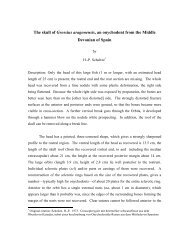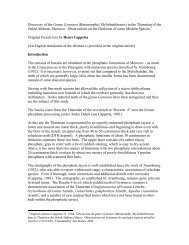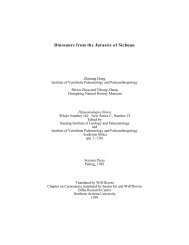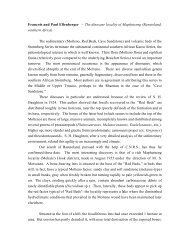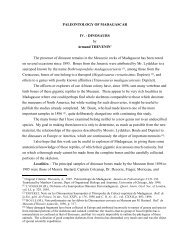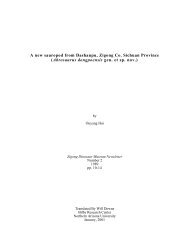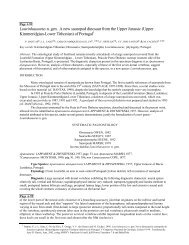Toothless Dinosaurs of Mongolia R. Barsbold Fossil Vertebrates of ...
Toothless Dinosaurs of Mongolia R. Barsbold Fossil Vertebrates of ...
Toothless Dinosaurs of Mongolia R. Barsbold Fossil Vertebrates of ...
Create successful ePaper yourself
Turn your PDF publications into a flip-book with our unique Google optimized e-Paper software.
<strong>Toothless</strong> <strong>Dinosaurs</strong> <strong>of</strong> <strong>Mongolia</strong><br />
R. <strong>Barsbold</strong><br />
<strong>Fossil</strong> <strong>Vertebrates</strong> <strong>of</strong> <strong>Mongolia</strong><br />
Academy <strong>of</strong> Sciences <strong>of</strong> USSR<br />
Paleontological Institute<br />
Academy <strong>of</strong> Sciences <strong>of</strong> the MPR<br />
Geological Institute<br />
Nauka<br />
Moscow 1981<br />
Trudy Issue 15<br />
Pp. 28-39<br />
Translated by Catherine Siskron and S. P. Welles<br />
Transcribed by Nathan D. Smith<br />
Courtesy <strong>of</strong> University <strong>of</strong> California, Berkeley Museum <strong>of</strong> Paleontology
Until recently only one group <strong>of</strong> toothless theropods—Ornithomimidae<br />
Marsh, 1890 is well-known and consistently studied on the North American<br />
continent (Osborn, 1902, 1917; Parks, 1926, 1928, 1933; Gilmore, 1920;<br />
Sternberg, 1933). The discovery <strong>of</strong> Central Asian fauna opened up the borders <strong>of</strong><br />
distribution <strong>of</strong> ornithomimids, the remains <strong>of</strong> which were fond in Northern China<br />
and <strong>Mongolia</strong> (Gilmore, 1933; Russell, 1972; Osmolska et al., 1972; Kielan-<br />
Jaworowska and <strong>Barsbold</strong>, 1972).<br />
In recent years the collection <strong>of</strong> toothless theropods has widened<br />
considerably, especially due to the additions to the collection <strong>of</strong> the Soviet-<br />
<strong>Mongolia</strong>n paleontological expedition, which facilitated a fuller examination <strong>of</strong><br />
questions <strong>of</strong> systematics, morphology, and evolution <strong>of</strong> these specific<br />
carnivorous dinosaurs, currently classified as belonging to the infraorders<br />
Ornithomimosauria and Oviraptorosauria (<strong>Barsbold</strong>, 1976a, 1977). In the first<br />
group are found garudimimids, primitive ornithomimosaurs, which in the area <strong>of</strong><br />
skull anatomy confirmed the specificity <strong>of</strong> the structure <strong>of</strong> the capsular<br />
basisphenoid, initially established in the <strong>Mongolia</strong>n ornithomimids (Osmolska et<br />
al., 1972), which comprise a progressive branch. The second group includes<br />
Oviraptor (<strong>Barsbold</strong>, 1976a, b), which in the initial stage <strong>of</strong> investigation was<br />
classified with the ornithomimids (Osborn, 1924) mainly due to its toothlessness<br />
and having been preserved in a similar position (Rozhdectvenskiy and Tatrinov,<br />
1961; Lapparent and Laocat, 1955; Huene, 1956; Romer, 1956; Kuhn, 1966;<br />
White, 1973). Beside the Oviraptor itself (Osborn, 1924), in the currently<br />
obtained new material with a high degree <strong>of</strong> preservation, stands out the specific<br />
genus Ingenia, classified in the new sub-family oviraptorid.<br />
2
Similarities were shown recently (Osmolska, 1976) between the lower jaw<br />
<strong>of</strong> Oviraptor and Caenagnathus Sternberg, 1940 (in which this is the only part<br />
that is known), which was earlier identified as belonging to birds (Sternberg,<br />
1940; Cracraft, 1971). H. Osmul’skaya (Osmolska, 1976) allows the possibility <strong>of</strong><br />
unifying Oviraptor and Caenagnathus in an earlier identified family<br />
Caenagnathidae Sternberg, 1940. However, considerable differences in the<br />
structure <strong>of</strong> the lower jaw <strong>of</strong> Caenagnathus and Oviraptor make it necessary to<br />
assign them to different families, which enter the infra-order Oviraptorosauria. In<br />
sum, the number <strong>of</strong> branches <strong>of</strong> toothless theropods increases to four:<br />
Ornithomimidae Marsh, 1890, Garudimimidae <strong>Barsbold</strong> fam. Nov., Oviraptoridae<br />
<strong>Barsbold</strong>, 1976, Caenagnathidae Sternberg, 1940, examined below in the light <strong>of</strong><br />
the new <strong>Mongolia</strong>n collections <strong>of</strong> recent years.<br />
INFRAORDER ORNITHOMIMOSAURIA<br />
ORNITHOMIMOSAURIA: BARSBOLD, 1976a, P. 74<br />
Diagnosis: Moderately large theropods with a small skull, elongated toothless<br />
jaws, equipped with a horny beak, with a capsular basisphenoid and parabasal<br />
canals. The palatal complex is <strong>of</strong> the reptilian type. The anterior limbs are not<br />
reduced, relatively weakly developed, with a non-pulley type wrist and hand <strong>of</strong><br />
the non-grasping type.<br />
All three metacarpal elements are approximately equal, the claw<br />
phalanges <strong>of</strong> the hand are more or less straight. The ilium is elongated in a<br />
different way, the pubis has a small “shoe-like” thickening, the ischium has a<br />
proximally displaced elongation, the proximal compression <strong>of</strong> its third elements is<br />
varied, the foot structure is three or four toed.<br />
3
Composition: Family Ornithomimidae Marsh, 1890, Garudimimidae<br />
<strong>Barsbold</strong>, fam. nov.<br />
Comparison: According to size, the ornithomimosaurs are approximately<br />
equal or somewhat larger than the “small” theropods, in one case the <strong>Mongolia</strong>n<br />
specimen reached the dimensions <strong>of</strong> a tyrannosaurid (Osmolska et al., 1972).<br />
The basisphenoidal capsule is perforated posteriorly by a large opening, while in<br />
the saurornithoidids (Coelorosauria), the second group with such a capsule<br />
(<strong>Barsbold</strong>, 1974), it is <strong>of</strong> the closed type.<br />
Parabasal canals among theropods were first found in the<br />
ornithomimosaurs and are connected with the development <strong>of</strong> the basisphenoidal<br />
capsule, that allows the presence <strong>of</strong> similar canals also in the saurornithoidids.<br />
The unreduced anterior limbs are characterized by a narrow humerus and<br />
antebrachium, that is a weak development <strong>of</strong> the deltopectoral crest and the<br />
ulnar join, which is also common to the Deinocheirids (Osmolska and Roniewicz,<br />
1970) as opposed to other theropods with unreduced front limbs. The roughly<br />
equal metacarpal elements are found also in the deinocheirids, among other<br />
theropods the first element is usually highly reduced in length. The non-pulley<br />
type wrist joint was also characteristic to the non-grasping hand in the<br />
tyrannosaurids and supposedly in the deinocheirids (<strong>Barsbold</strong>, 1976c). The<br />
ornithomimosaural pelvis in general is similar to that <strong>of</strong> the carnosaurs<br />
(allosaurids, tyrannosaurids), but it is considerably smaller in size as well as<br />
mass. The distal “shoe-like” thickening <strong>of</strong> the pubis is considerably less than in<br />
the named groups. The wide amplitude <strong>of</strong> diversions in the structure <strong>of</strong> the foot<br />
in the ornithomimosaurs—the degree <strong>of</strong> the elongation <strong>of</strong> the metatarsus and the<br />
4
proximal compression <strong>of</strong> its third element, is observed in various theropods, but<br />
usually does not reach such a significant dimension inside a single group, most<br />
clearly illustrated by the loss <strong>of</strong> the first toe <strong>of</strong> the foot. The ventral flattening <strong>of</strong><br />
the unguals <strong>of</strong> the foot is perceived as a distinguishing peculiarity <strong>of</strong> the<br />
ornithomimosaurs.<br />
Distribution: Cretaceous, North America, Central Asia<br />
FAMILY ORNITHOMIMIDAE MARSH, 1890<br />
Genus type: Ornithomimus Marsh, 1890<br />
Ornithomimidae Marsh, 1890, p. 84<br />
Diagnosis: Progressive ornithomimosaurs with elongated ilia (longer than the<br />
pubis) and metatarsus, proximally highly compressed third metatarsal element<br />
and without the first toe (pollex). Pleurocoels are present.<br />
Generic composition: Ornithomimus Marsh, 1890; Struthiomimus Osborn,<br />
1917; Dromiceiomimus Russell, 1972; Archaeornithomimus Russell, 1972;<br />
Gallimimus Osmolska, Roniewicz and <strong>Barsbold</strong>, 1972.<br />
Distribution: Early (upper Albian) and Late (Senonian) Cretaceous; North<br />
America, Central Asia (South Eastern and South Western <strong>Mongolia</strong>).<br />
FAMILY GARUDIMIMIDAE BARSBOLD, FAM. NOV.<br />
Generic type: Garudimimus <strong>Barsbold</strong>, gen. nov.<br />
Diagnosis: Primitive ornithomimosaurs with shortened ilia (shorter than<br />
pubis) and metatarsus, proximally almost not compressed third metatarsal and<br />
first toe (pollex). Pleurocoels are absent.<br />
Generic composition: Monotypic family.<br />
5
Comparison: Primitive ornithomimosaurs are differentiated from<br />
progressive by the following features: ilia are shorter than pubis, third metatarsal<br />
is proximally almost not compressed, and this defines its considerable<br />
participation in the tarsal joint and the full separation <strong>of</strong> the second and fourth<br />
metatarsals which adjoin one another in the progressive representatives <strong>of</strong> the<br />
group.<br />
<strong>Mongolia</strong>).<br />
Distribution: Late Cretaceous (Senonian), Central Asia (South Eastern<br />
Genus Garudimimus <strong>Barsbold</strong>, gen. nov.<br />
The name <strong>of</strong> the genus is taken after the bird Garudi in the mythology <strong>of</strong><br />
eastern peoples.<br />
Species type: Garudimimus brevipes <strong>Barsbold</strong>, gen. et sp. nov.<br />
Genus composition: Monotypic species<br />
Distribution: Early Senonian, South Eastern <strong>Mongolia</strong>.<br />
Garudimimus brevipes <strong>Barsbold</strong>, sp. nov.<br />
Fig. 1-4<br />
Name <strong>of</strong> species from brevis, Latin “short”; pes, Latin “foot”.<br />
Holotype: #100/13, GIN AN MNR; skull; fragments <strong>of</strong> axial skeleton, pelvis<br />
and incomplete posterior limbs; lower Senonian, Bayanshipensk suite, Bayshin-<br />
Tsav location, South Eastern <strong>Mongolia</strong>.<br />
Material: Holotype<br />
Description: Skull (Fig. 1). Ventral part <strong>of</strong> the base <strong>of</strong> the open<br />
basisphenoidal capsule in front <strong>of</strong> the basipterygoidal processes (to which it<br />
passed without interruption) connected with the medial edges <strong>of</strong> the pterygoids,<br />
6
dorsally, but covering the interpterygoidal cavity. Such additional articulation <strong>of</strong><br />
the capsule with thepterygoids must have blocked the basipterygoidal<br />
articulation, denying it mobility. Interpterygoidal cavity is considerably reduced.<br />
Entering openings <strong>of</strong> the parabasal canals (Fig. 2) are located immediately in<br />
front <strong>of</strong> the horizontally directed and shortened basipterygoidal processes.<br />
Anteriorly and laterally from the openings, adjoin the pterygoids, lining their areas<br />
next to the edge. The epipterygoids in the shape <strong>of</strong> V-shaped lamella, are<br />
ventrally wider. In the lower jaw the lamella ends in a V-shape, without reaching<br />
the symphysis. The coronary is absent. The retroarticular process is widened,<br />
with dorsally open large recess, which attached m. depressor mandibulae. The<br />
medial edge <strong>of</strong> the process was highly thickened and, apparently, rested against<br />
the base <strong>of</strong> the quadrate, interfering, as in the case <strong>of</strong> the dromesaurid (Colbert<br />
and Russell, 1969) to the extreme displacement <strong>of</strong> the lower jaw.<br />
The dorsal and sacral (caudal are not in the collection) vertebrae have no<br />
pleurocoels. There are six sacral vertebrae. The distal end <strong>of</strong> the left rib is<br />
separated from the diapophysis and leans against the medial surface <strong>of</strong> the ilium.<br />
The ilium is high, a little shorter than the pubis, with narrowed posterior<br />
wing, the upper and lower edge <strong>of</strong> which are sub-parallel.<br />
The femur is insignificantly shorter than the tibia. III tarsal element lay on<br />
the proximal articular surfaces <strong>of</strong> predominantly the III and only partially the II<br />
metatarsal bones. IV tarsal element fully articulated with same named<br />
metatarsal bone. In the foot (Fig. 3) three basic (II, III, IV) and two residual (I, V)<br />
metatarsals. I metatarsal has a reduced, distally V-shaped trunk, adjacent to the<br />
II metatarsal. Distal metatarsal is the shortest and thickest, its proximal end is<br />
7
anteriorly widened, posteriorly slightly compressed. The III is the most thickened<br />
and elongated, in the distal part slightly curved, in the proximal part slightly<br />
compressed. IV metatarsal in length occupied intermediary position between II<br />
and III, its proximal end is widened. Distal head <strong>of</strong> the bones with convex<br />
articular surfaces, are slightly divided sagitally by a furrow. V metatarsal is highly<br />
reduced to a narrow, laterally compressed residual element, attached to the IV<br />
metatarsal. The first toe (Fig. 4) is the most reduced, its ungula is noticeably<br />
compressed from the sides. Phalanges <strong>of</strong> each <strong>of</strong> the remaining toes decreased<br />
progressively in the distal direction, which is best expressed in the fourth toe, the<br />
ungula <strong>of</strong> which has a flattened ventral surface (in the second and third toes the<br />
unguals are not known).<br />
Observations: According to the development <strong>of</strong> the basisphenoidal<br />
capsule, which is open posteriorly, the skull <strong>of</strong> Garudimimus is in many aspects<br />
similar to that <strong>of</strong> Gallimimus. It was possible to establish that in the latter that the<br />
so-called basipterygoidal branches <strong>of</strong> the pterygoids (Osmolska et al., 1972) in<br />
reality are the epipterygoids. The same type <strong>of</strong> skull structure in Garudimimus<br />
and Gallimimus allow the generalization <strong>of</strong> the development <strong>of</strong> the<br />
basisphenoidal capsule and the blocked basipterygoidal articulation for the whole<br />
group (there is a possibility <strong>of</strong> the presence <strong>of</strong> the capsule in one <strong>of</strong> the American<br />
species, see Parks, 1933; Osmolska et al., 1972). Parabasal canals have similar<br />
structures, and most likely were a distinguishing characteristic for the whole<br />
group. The capsule (closed type), the supposed blocked basipterygoidal<br />
articulation and the horizontal orientation <strong>of</strong> the basipterygoidal processes in the<br />
saurornithoidids (<strong>Barsbold</strong>, 1974) create an expectation <strong>of</strong> the development <strong>of</strong><br />
8
the parabasal canals also in this family <strong>of</strong> theropods. The shortness <strong>of</strong> the ilium<br />
and the metatarsus, the lack <strong>of</strong> compression <strong>of</strong> the III metatarsal and the<br />
development <strong>of</strong> the first toe differentiate Garudimimus from all representatives <strong>of</strong><br />
the progressive branch <strong>of</strong> the ornithomimosaurs.<br />
Geologic age: Lower Senonian, Bayasirensk suite.<br />
Location: South Eastern <strong>Mongolia</strong>, location Bay-shin-tsav.<br />
INFRAORDER OVIRAPTOROSAURIA<br />
Oviraptorosauria: <strong>Barsbold</strong>, 1975a, p.74<br />
Diagnosis: Small and moderately large theropods with toothless jaws<br />
which formed a massive beak. Dental bone has two processes, separated by<br />
large lateral openings. The articular joint <strong>of</strong> the lower jaw has a massive<br />
longitudinal projection.<br />
Composition: Family Oviraptoridae <strong>Barsbold</strong>, 1976; and Caenagnathidae<br />
Sternberg, 1940.<br />
Comparison: Oviraptorosaurs are the second group <strong>of</strong> toothless<br />
theropods, basically differentiated from ornithomimosaurs by the development <strong>of</strong><br />
a massive beak and the highly specific in configuration and structure <strong>of</strong> the lower<br />
jaw with the characteristic articular joint.<br />
Distribution: Late Cretaceous, Central Asia.<br />
FAMILY OVIRAPTORIDAE BARSBOLD, 1976<br />
Oviraptoridae: <strong>Barsbold</strong>, 1976b, p. 685.<br />
Generic type: Oviraptor Osborn, 1924.<br />
Diagnosis: Small and moderately large oviraptorosaurs with intense<br />
fenestration <strong>of</strong> the skull and jaws with a reduced occlusive part, which formed a<br />
9
short beak. The basisphenoidal capsule is absent. Vomers, fused with the jaw<br />
bones, by means <strong>of</strong> a tooth-like projection connected with the pterygoids, by the<br />
dividing choanae. Ectopterygoids are highly displaced forward. Basipterygoidal<br />
articulation is immobile. Lower jaw with convex occlusal edge, large adductoral<br />
projection, short symphysis and large lateral opening. The dental has two<br />
posterior processes. Vertebrae, including the caudal, have pleurocoels. The<br />
clavicle articulated with the acromial process <strong>of</strong> the scapula. In the tridactyl hand<br />
with the pulley wrist the fingers are reduced in varying degrees. The pubis has a<br />
small distal “shoe-like” thickening, and is shorter than the ilium. Obturator<br />
process <strong>of</strong> the shortened ischium is displaced distally. The third metatarsal is not<br />
proximally compressed. The foot is structurally four-toed.<br />
Composition: Subfamily Oviraptorinae Osborn, 1924; and Ingeniinae<br />
<strong>Barsbold</strong>, subfam. nov.<br />
<strong>Mongolia</strong>.<br />
fingers.<br />
Distribution: Late Cretaceous (Senonian), South and Southwestern<br />
Generic type: Oviraptor Osborn, 1924.<br />
Diagnosis: Moderately large oviraptorids with unreduced second and third<br />
Composition: Genus Oviraptor Osborn, 1924.<br />
Distribution: Senonian, South and Southwestern <strong>Mongolia</strong>.<br />
Genus Oviraptor Osborn, 1924<br />
Oviraptor: Osborn, 1924, p. 7; <strong>Barsbold</strong>, 1976, p. 687.<br />
Species type: Oviraptor philoceratops Osborn, 1924; Upper Cretaceous,<br />
Djdohya Formation, Shabarak-Usu (Bain-Dzak), South <strong>Mongolia</strong>.<br />
10
Diagnosis: Oviraptorids with large curved and laterally compressed<br />
unguals <strong>of</strong> the second and third finger.<br />
Composition: Monotypic genus<br />
Distribution: Senonian, South and Southwestern <strong>Mongolia</strong>.<br />
Oviraptor philoceratops Osborn, 1924<br />
Fig. 5-9<br />
Oviraptor philoceratops: Osborn, 1924, p. 7; <strong>Barsbold</strong>, 1976b, p. 687.<br />
Holotype: AMNH 6517; incomplete skull and remains <strong>of</strong> the postcranial<br />
skeleton; Upper Cretaceous, Djdohta Formation, Shabarak-Usu (Bain-Dzak),<br />
South <strong>Mongolia</strong>.<br />
Material: Skull and postcranial skeleton (#100/42) <strong>of</strong> an adult specimen in<br />
good preservation and remains <strong>of</strong> four supposedly young specimens, #100/36<br />
has the best preserved skull).<br />
Description: Premaxilla which composes the basis <strong>of</strong> the massive upper<br />
part <strong>of</strong> the beak, forms the major part <strong>of</strong> the highly projected longitudinal crest<br />
with anterior paired openings and cancelous walls (fig. 5). The maxilla and the<br />
nasal are considerably shortened, the latter is widened and to a great degree<br />
also has cancelous structure. The paired vomers have large longitudinal ridges,<br />
posteriorly they fuse completely with the maxilla forming in the area <strong>of</strong> fusion a<br />
paired tooth-like projection, which forms the articular connection with the vomer<br />
processes <strong>of</strong> the thickened pterygoids, which separated the large choanae. The<br />
ectopterygoids are highly displaced anteriorly, their lateral processes entered in<br />
the connection <strong>of</strong> the lacrimal, jugal, and maxilla in the antero-ventral sector <strong>of</strong><br />
the orbit. The palatal as a result <strong>of</strong> considerable reduction had little participation<br />
11
in the structuring <strong>of</strong> the palatal region. The basisphenoidal capsule is absent.<br />
Basipterygoidal processes are not clearly defined, as a result <strong>of</strong> which the<br />
pterygoids are practically adjacent to the basicranium and we suppose fuse with<br />
it. The basal articular surface <strong>of</strong> the quadrate with two large convex condyles,<br />
divided by a deep cavity, participate in the formation <strong>of</strong> the reinforced quadrato-<br />
articular joint. The rising and the posteriorly directed processes <strong>of</strong> the dentary<br />
are divided by a lateral opening, which posteriorly is limited by the surangular,<br />
and a narrow process that subdivides the posterior edge <strong>of</strong> the opening into two<br />
unequal segments (fig. 6). The adductoral projection <strong>of</strong> the lower jaw has a high<br />
tubercular top.<br />
Six sacral vertebrae. Caudal vertebrae are shortened, with pleurocoels<br />
with the exception <strong>of</strong> the very last ones. The sternum (fig. 7) is formed from<br />
lamellar paired elements, sagittally connected. The clavicle (furcula) is V-shaped<br />
(fig. 8), with widely diverging branches, each <strong>of</strong> which articulated with the flat end<br />
<strong>of</strong> the acromial process. The ilium has a wide anterior and narrow posterior<br />
flange. The distal thickening <strong>of</strong> the pubis, in spite <strong>of</strong> the small proportions, is<br />
characterized by the “shoe-like” configuration. The ischium is shortened, with a<br />
large V-shaped obturator process, located approximately in the middle <strong>of</strong> the<br />
length <strong>of</strong> the bone.<br />
The first metacarpal is more than two times shorter than the second and<br />
third. The fingers are elongated (fig. 9), II and III are almost the same size; pre-<br />
claw phalanges in the latter are more elongated in comparison with the others.<br />
Unguals are highly curved, compressed from the sides, widened, with convex<br />
tubercles for the attachment <strong>of</strong> ligaments <strong>of</strong> finger flexors.<br />
12
Observations: Among the younger specimens <strong>of</strong> oviraptors the skull<br />
supposedly has no longitudinal osseous crest. The best preserved skull (100/36)<br />
in such a specimen shows no signs <strong>of</strong> a crest. It is possible that it wasn’t<br />
preserved in the fossilized state, especially if it was weakly expressed in the<br />
young forms. However, in the best preserved young specimen (100/36), the<br />
structure <strong>of</strong> the nasal and the frontal, which in part participated in the formation <strong>of</strong><br />
the crest, does not show any signs in favor <strong>of</strong> its presence. The osseous crest <strong>of</strong><br />
oviraptors in its general shape (not in terms <strong>of</strong> its composing elements and their<br />
location on the skull) in many ways is reminiscent <strong>of</strong> the crest <strong>of</strong> the casuarys<br />
and, possibly, was also covered by a horny cover, in favor <strong>of</strong> which testifies the<br />
cancelous walls <strong>of</strong> the crest, indicating an abundant blood supply. The osseous<br />
crest in oviraptors may have served as a sexual characteristic (which was<br />
present among the males). The development <strong>of</strong> the paired opening in the<br />
osseous base <strong>of</strong> the crest <strong>of</strong> oviraptors so far has not found a sufficiently<br />
consistent explanation.<br />
suites.<br />
Geologic age: Senonian, Djadoht Formaton, Djadohtsk and Barungoytsk<br />
Location: <strong>Mongolia</strong>, Bain-Dzak (Shabarak-Usu) and Hermin-tsav.<br />
SUBFAMILY INGENIINAE BARSBOLD, SUBFAM. NOV.<br />
Genus type: Ingenia <strong>Barsbold</strong>, gen. nov.<br />
Diagnosis: Small oviraptorids with reduced second and third fingers.<br />
Composition: Monotypic genus.<br />
Comparison: Differentiated from oviraptorin by a smaller size and reduced<br />
second and third fingers.<br />
13
Distribution: Late Senonian, Southwestern <strong>Mongolia</strong>.<br />
Genus Ingenia <strong>Barsbold</strong>, gen. nov.<br />
Species type. Ingenia yanshini <strong>Barsbold</strong>, sp. nov., Upper Senonian,<br />
Barungoysk suite, Hermin-tsav, Southwestern <strong>Mongolia</strong>.<br />
Diagnosis: Oviraptorids with highly reduced, slightly curved and<br />
compressed unguals <strong>of</strong> the second and third fingers.<br />
Comparison: Ingenia is differentiated from Oviraptor by the high reduction,<br />
compression and straightness <strong>of</strong> the unguals <strong>of</strong> the second and third fingers.<br />
Distribution: Late Senonian, Southwestern <strong>Mongolia</strong>.<br />
Ingenia yashini <strong>Barsbold</strong>, sp. nov.<br />
Fig. 10<br />
Species named in honor <strong>of</strong> academician A. L. Yanshin.<br />
Holotype: GIN AN MNR, #100/30, lower jaw and in many respects full<br />
postcranial skeleton; upper Senonian, Barngoyotsk suite, (upper part), Hermin-<br />
tsav, Southwestern <strong>Mongolia</strong>.<br />
Material: Besides the holotype, remains <strong>of</strong> a skull and postcranial<br />
skeleton, four specimens (#100/30-100/33).<br />
Description: First metacarpal is almost twice as short as second and third,<br />
which consequently are highly reduced. In the tridactyl hand the second and<br />
third fingers are progressively shorter than the first and are much thinner,<br />
however the number <strong>of</strong> phalanges which compose it are fully preserved. In the<br />
distal direction these phalanges are shortened, but the unguals are insignificantly<br />
longer than the pre-claw ones. The ungual <strong>of</strong> the first finger is large, slightly<br />
14
laterally compressed and curved, while in the second and third finger they are<br />
greatly reduced, narrow and more straight.<br />
Observation: The considerable similarity with Oviraptor makes it<br />
unnecessary to repeat those features that they share in common in the structure<br />
<strong>of</strong> the skull and the postcranial skeleton <strong>of</strong> Ingenia, which were already described<br />
for the first species. In Ingenia the bones are differentiated by greater massivity,<br />
disproportional to their smaller size. The degree <strong>of</strong> preservation <strong>of</strong> the skull<br />
material does not allow one to judge concerning an osseous crest <strong>of</strong> Ingenia.<br />
Geologic age: Upper Senonian, Barungoyotsk suite (upper part).<br />
Location: Hermin-tsav, Southwestern <strong>Mongolia</strong>.<br />
FAMILY CAENAGNATHIDAE STERNBERG, 1940<br />
Caenagnathidae: Sternberg, 1940, p. 81; Cracraft, 1971, p. 805.<br />
Genus type: Caenagnathus Sternberg, 1940.<br />
Diagnosis: Moderately large oviraptorosaurs, the lower jaw <strong>of</strong> which is<br />
elongated and concave in the occlusal part, low adductoral projection, elongated<br />
symphysis and narrowed lateral opening.<br />
Composition: One genus Caenagnathus Sternberg, 1940.<br />
Comparison: According to the type <strong>of</strong> lower jaw structure the<br />
caenagnathid is principally similar with that <strong>of</strong> the oviraptorid and does not have<br />
analogues among other toothless theropods. At the same time its general<br />
proportions and the character <strong>of</strong> the parts composing it are basically different<br />
from that <strong>of</strong> the lower jaw <strong>of</strong> oviraptorids. Among the characteristics that<br />
differentiate the caenagnathids are the size and configuration <strong>of</strong> the occlusal<br />
15
part, the degree <strong>of</strong> development <strong>of</strong> the adductoral extension, the character <strong>of</strong> the<br />
symphysis, and the shape and size <strong>of</strong> the lateral opening.<br />
Remarks: During the first description <strong>of</strong> the caenagnathids were placed in<br />
an independent order <strong>of</strong> birds (Sternberg, 1940), which found support later<br />
(Russell, 1964; Cracraft, 1971), although ornithologists denied the presence <strong>of</strong><br />
bird characteristics and stressed the common reptilian structure <strong>of</strong> the lower jaw<br />
(Wetmore, 1956, 1960). The new finds <strong>of</strong> the oviraptorids in <strong>Mongolia</strong> led to the<br />
placement <strong>of</strong> the caenagnathids with the theropods (Osmolska, 1976).<br />
Distribution: Late Cretaceous, North America.<br />
Genus Caenagnathus Sternberg, 1940<br />
Caenagnathus: Sternberg, 1940, p. 81; Cracraft, 1971, p. 805.<br />
Species type: Caenagnathus collinsi Sternberg, 1940; Upper Cretaceous,<br />
Oldman Formation, Alberta, Canada.<br />
Caenagnathus collinsi Sternberg, 1940<br />
Fig. 11<br />
Caenagnathus collinsi: Sternberg, 1940, p. 81; Cracraft, 1971, p. 805.<br />
Holotype: NMC P-3605/8776; partially damaged lower jaw; Upper<br />
Cretaceous, Oldman Formation, Alberta, Canada.<br />
Material: Holotype.<br />
Description: Dentary (fig. 11a, b) occupies at least two thirds <strong>of</strong> the length<br />
<strong>of</strong> the lower jaw. Its occlusal edge is equally concave throughout. The<br />
symphysis occupies a little less than half <strong>of</strong> the length <strong>of</strong> the dentary. The rostral<br />
part is flared, slightly concave, with longitudinal convex ridge-like crests,<br />
supposedly connected with the development <strong>of</strong> the thickened ramphothec<br />
16
(????). The processes <strong>of</strong> the dentary are horizontally directed posteriorly. The<br />
top <strong>of</strong> the low adductoral projection is displaced posteriorly and is located on the<br />
middle <strong>of</strong> the length <strong>of</strong> the oblong lateral opening, the antero-ventral limited area<br />
the edges <strong>of</strong> which are formed by the dentary, upper edge almost completely by<br />
the surangular, the posterior by the surangular and angular. The articular joint<br />
surface has a rounded outline, with a longitudinal projection, which divides the<br />
articular processes, <strong>of</strong> which the medial is wider than the lateral, with a massive<br />
retroarticular process, slanted downwards.<br />
Observation: In the framework <strong>of</strong> the general features <strong>of</strong> similarity <strong>of</strong> the<br />
lower jaw <strong>of</strong> caenagnathids and oviraptoris the basic differences between them<br />
are as follows:<br />
Caenagnathids Oviraptors<br />
Gently sloping concavity along Slight concavity only in the<br />
the entire occlusal edge. extreme anterior part <strong>of</strong> the<br />
edge, the rest is convex.<br />
Symphysis elongated. Symphysis shortened.<br />
Lateral opening is displaced Opening, displaced forward,<br />
posteriorly, rounded, wide, narrow, elongated, undivided.<br />
consists <strong>of</strong> two sections.<br />
Upper edge <strong>of</strong> the opening is Upper edge is formed by the<br />
formed by the surangular dentary, posterior by the<br />
and angular surangular.<br />
Adductoral projection is located Projection is located posteriorly<br />
above the middle <strong>of</strong> the lateral to the opening.<br />
opening.<br />
Upper process <strong>of</strong> the dentary is Process is directed along an<br />
directed horizontally to the arch dorsally and posteriorly.<br />
Posterior.<br />
17
It is important to note, that in contrast to the original material on oviraptorids the<br />
study <strong>of</strong> Caenagnathus in this case was based only on written material, in many<br />
areas highly limited. This is why only the most basic, documented features were<br />
taken into consideration in the characterization <strong>of</strong> its lower jaw, in the background<br />
<strong>of</strong> similarity with the oviraptor characterization forming also considerable<br />
differences. In all likelihood, the detailed study <strong>of</strong> the original material will<br />
considerably broaden the basis <strong>of</strong> both the similarities and the differences<br />
between these animals.<br />
Geologic age: Upper Cretaceous, Oldman Formation.<br />
Location: Alberta, Canada.<br />
Caenagnathus sternbergi Cracraft, 1971<br />
Caenagnathus sternbergi: Cracraft, 1971, p. 806.<br />
Holotype: NMC #2690; posterior end <strong>of</strong> the right lower jaw branch; Upper<br />
Cretaceous, Oldman Formation, Steveville, Alberta, Canada.<br />
Material: Holotype.<br />
The extreme limitedness <strong>of</strong> the existing material makes it difficult to<br />
examine. We can only note that the configuration <strong>of</strong> the articular surface is<br />
somewhat different from that <strong>of</strong> the species type.<br />
Geologic age: Upper Cretaceous, Oldman formation.<br />
Location: Steveville, Alberta, Canada.<br />
Development <strong>of</strong> <strong>Toothless</strong> Theropods<br />
Despite the high degree <strong>of</strong> specificity, the toothless carnivorous dinosaurs<br />
share the common theropod structure, which is especially easy to observe in the<br />
postcranial skeleton. At the same time, such peculiar features <strong>of</strong> the skull<br />
18
anatomy, as the recently discovered basisphenoidal capsule, the blockage <strong>of</strong> the<br />
basipterygoidal articulation, the development <strong>of</strong> the parabasal canals, were not<br />
exclusive to the ornithomimosaurs. Among other groups, the most remarkable in<br />
this sense are the saurornithoidids (<strong>Barsbold</strong>, 1974) and the segnosaurs (Perle,<br />
1979). The establishment <strong>of</strong> the primitive ornithomimosaurs with the developed<br />
first toe and the specific differentiation from the better known progressive forms<br />
confirms the theory <strong>of</strong> development <strong>of</strong> this whole group from a basic theropod<br />
branch. The primitive ornithomimosaurs apparently developed for a long time in<br />
the zone <strong>of</strong> adaptation, fairly close to the basic progressive branch. We can<br />
allow the possibility that, that in the representatives <strong>of</strong> the latter occurred a<br />
displacement, which only deepened the “ornithomimid” specialization. The<br />
parallel evolution <strong>of</strong> the two lines occurred already in the Early Cretaceous <strong>of</strong><br />
<strong>Mongolia</strong>, judging by the undescribed fine in the Southeast <strong>of</strong> the most ancient<br />
progressive ornithomimids (Hurenduh, upper Dzunbaysk suite; Aptian-Albian;<br />
another progressive ornithomimid is known from approximately the same time in<br />
the Cloverly Formation, USA (see Ostrom, 1970).<br />
The development <strong>of</strong> oviraptorosaurs went by a path that demanded<br />
different adaptations, which are the most clearly expressed in the structure <strong>of</strong> the<br />
peculiar toothless jaw apparatus. The evolution <strong>of</strong> oviraptorosaurs was directed<br />
toward the strengthening compressing possibilities <strong>of</strong> their jaws, adapted for the<br />
squashing <strong>of</strong> hard objects (<strong>Barsbold</strong>, 1977).<br />
We must particularly note the general principal similarity <strong>of</strong> the lower jaw<br />
<strong>of</strong> the oviraptorids and the caenagnathids, which suggests the possibility <strong>of</strong><br />
19
kinship. Apparently, caenagnathids developed in the adaptive zone, different<br />
from that <strong>of</strong> the oviraptorids, but on the basis <strong>of</strong> a single original structural plan.<br />
The absence <strong>of</strong> the clavicle and sternum (the remains <strong>of</strong> the poorly<br />
preserved one not taken into consideration) among the carnivorous dinosaurs<br />
always in the past served as negative pro<strong>of</strong> <strong>of</strong> a possible connection with birds.<br />
Presently the oviraptorids—the first group <strong>of</strong> theropods, where the clavicles were<br />
not only present, but had bird structure, and the sternum was similar to the<br />
analogous structure in the keel-less birds. If one is to add to this the<br />
pneumatization <strong>of</strong> some <strong>of</strong> the skull bones (Osmolska, 1976) and the<br />
development <strong>of</strong> the crest, in general similar with the casuary’s crest covered by a<br />
horny shield, then oviraptorids occupy one <strong>of</strong> the most interesting positions in the<br />
comparative morphology <strong>of</strong> birds and carnivorous dinosaurs, which is actively<br />
being developed in recent years (Ostrom, 1973, 1976).<br />
20
REFERENCES<br />
21
Fig. 1. Garudimimus brevipes <strong>Barsbold</strong>, sp. nov.; #100/13, GIN AN MNR: skull (without lower<br />
jaw) view from the right; Southeastern <strong>Mongolia</strong>, Bayshin-tsav, Upper Cretaceous, Bainshiereinsk<br />
suite. cbs—basispenoidal capsule.<br />
Fig. 2. Garudimimus brevipes <strong>Barsbold</strong>, sp. nov.; #100/13, GIN AN MNR: skull, ventral view<br />
(schematized). Bo—basioccipital, Ec—ectopterygoid, Pt—pterygoid, Qu—quadrate,<br />
bpt—basipterygoidal process, opb—entrance opening <strong>of</strong> the parabasal canal,<br />
ipt—interpterygoidal cavity, spo—sphenoocipital tubercle.<br />
Fig. 3. Garudimimus brevipes <strong>Barsbold</strong>, sp. nov.; #100/13, GIN AN MNR: first metatarsus,<br />
anterior view.<br />
Fig. 4. Garudimimus brevipes <strong>Barsbold</strong>, sp. nov.; #100/13, GIN AN MNR: phalanges <strong>of</strong> the right<br />
foot, internal view.<br />
23
Fig. 5. Oviraptor philoceratops Osborn, 1924; #100/42, GIN AN MNR; skull (without lower jaw),<br />
left lateral view; South <strong>Mongolia</strong>, Dzamyn-Hond, Upper Cretaceous, Dzhahodsk suite (Dzhaohta<br />
Formation). Mx—maxilla, Pmx—premaxilla, pd-tooth-like processes in the area <strong>of</strong> fusion <strong>of</strong><br />
vomers with maxilla, rc—paired openings <strong>of</strong> the osseous crest. Remaining designations are the<br />
same as in fig. 2.<br />
24
Fig. 6. Oviraptor philoceratops Osborn, 1924; #100/42, GIN AN MNR: lower jaw, left lateral view.<br />
Ar—articular, D—dentary, Sa—prearticular.<br />
Fig 7. Oviraptor philoceratops Osborn, 1924; #100/42, GIN AN MNR: sternum, anterior view.<br />
Fig 8. Oviraptor philoceratops Osborn, 1924; clavicles, anterior view. A--#100/36, GIN AN MNR,<br />
young specimen; Southwestern <strong>Mongolia</strong>, Hermin-Tsav, Barngoyotsk suite (lower part). B--<br />
#100/42, GIN AN MNR; adult specimen; South <strong>Mongolia</strong>, Dzamyn-Hond, Dzhadostsk suite,<br />
Dzhadohta Formation.<br />
Fig. 9. Oviraptor philoceratops Osborn, 1924; #100/42, GIN AN MNR; phalanges <strong>of</strong> the right<br />
manus, internal view.<br />
25
Fig. 10. Ingenia yashini <strong>Barsbold</strong>, sp. nov.; #100/30, GIN AN MNR; phalanges <strong>of</strong> the right<br />
manus, interior view; Southwestern <strong>Mongolia</strong>, Hermin-tsav, Upper Cretaceous, Barungoyotsk<br />
suite (upper part).<br />
Fig. 11. Caenagnathus collinsi Sternberg, 1940; #P—3605/8776, NMC, Museum <strong>of</strong> Natural<br />
History <strong>of</strong> Canada; lower jaw; Canada, Alberta, Upper Cretaceous, Oldman Formation. a—lateral<br />
view; b—medial view (the majority <strong>of</strong> the right lower jaw branch is eliminated), An—angular.<br />
Remaining designations are the same as in fig. 6.<br />
26



